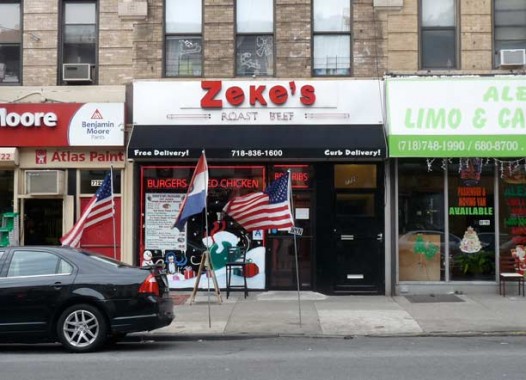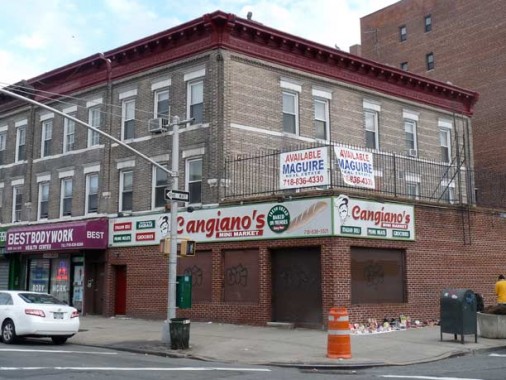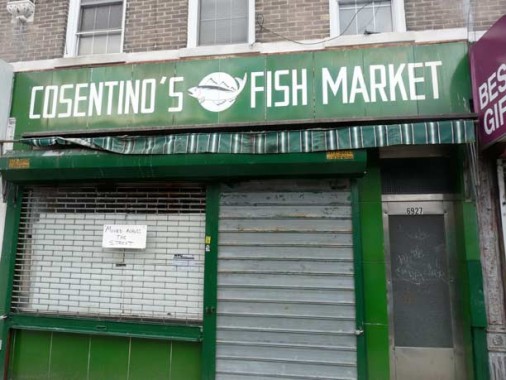Today’s featured walk sent me from Bay Ridge after a dental appointment southeast and east through Sunset Park and Borough Park at the border of Kensington. Well-worn territory for me, and suffused with familiarity and memories…since I was born, raised and spent my first 35 years there. Still, I can always find some little-trodden ground in any exploration. For example, I had really never walked or paid much attention to the section of Fort Hamilton Parkway between 56th Street and Ocean Parkway all that much. Why? The answer is simple: the B16 bus turns at 56th and heads for 14th Avenue (it turned on 13th before it became one way). On a bike, I mostly avoided FHP, since it tends to be a busy truck route. To get to Kensington I usually used quiet 14th Avenue…
I began after lunch at Zeke’s Roast Beef on 3rd and 77th. My history with Zeke’s has been mentioned ad infinitum here before, so I won’t tell the story again, but it’s some of the best fast food in Brooklyn and I ate there once a week from 1982 till I moved in 1993. After finishing lunch, I spoke to the owner, who was outside and I congratulated him on the recipe staying exactly the same after a few years’ hiatus after they left their original location (see below). He remembered me as regular customer. I can’t be anymore, but I go in whenever I can.
There have been some changes on 3rd Avenue. Cangiano’s, which was on the corner of 3rd and Ovington for quite awhile, has left the building.
A couple of doors down, the similarly-named Cosentino’s Fish Market has moved across the street, which means its classic green and white sign will soon be gone.
They gave it the old college try with that new sign, but the artificially condensed lettering and non-curly apostrophe makes the average type professional cringe. At least they still have a fish on the sign. (Established 1920, during the Wilson Administration)
Bay Ridge and Sunset Park used to have a high Scandinavian population; there was a lot of dock work and many immigrants worked on the waterfront. Many of the Norwegians, Swedes, Danes and Finns of southwest Brooklyn have moved away (there are still more than you’d think!) and the Norwegian Day parade, commemorating independence from Sweden, is still held in May. Along the way we will see some Norse vestiges. Leske’s Bakery recently closed (my mother’s bakery of choice, Lund’s, is very long gone), but this gift shop on 3rd near Bay Ridge Avenue (69th Street, as the locals say) is still in business, though not open this day.
In a world of Walgreens, CVS and Rite Aid, the neighborhood pharmacy is still a welcome institution. Lowen’s Pharmacy saw tragedy a few years ago, however, when one of the owners committed suicide after he had been implicated in a steroids scandal.
A couple of buildings on 3rd Avenue have retained their corner turrets and complicated roofline corbelling, and thus, advertise their century-old lineage. Lower Bay Ridge developed as a small town relatively early on, by the 1850s.
Arthur Treacher’s Fish & Chips used to have a lot greater coverage than it does today, when it’s down to a handful of outlets, and this one has to share space with 2 other fastfood joints. Treacher, by the way, was a real person, a British actor who got a lot of work in light comedies of manners from the 1930s-1950s, playing butlers (most notably P.G. Wodehouse’s Jeeves, who became the symbol of ask.com) and military men. I’m old enough to remember him primarily as Merv Griffin’s dry sidekick on his evening show on Channel 5, which my mother would rarely miss. Late in life, he licensed his name to the fish & chips slinger, though he had little other to do with the place.
Here he is dancing with Shirley Temple…
The Bay Ridge (twin) Towers are apartment buildings, seen here from 3rd Avenue and from Shore Road Drive, that went up in the early 1970s. Outside of downtown, they are still among Brooklyn’s tallest buildings at 30 floors apiece. Both are built on platforms above the NY & Atlantic (Long Island Rail Road) tracks, which are sparingly used for freight.
Shore Road Drive
One of Bay Ridge’s relative secrets is the scenic Shore Road Drive, which first appears on maps (like this Belcher-Hyde plate) in the 1920s, running from Shore Road at Owls Head Park all the way to Fort Hamilton Parkway. It was first called Bay Ridge Parkway, but some time after 1929 a switcheroo was made and 75th Street became Bay Ridge Parkway, and this became Shore Road Drive. The road used to run all the way through Lief Eiriksson Square to Ft. Hamilton Parkway, but as likely part of reconfigurations after the Belt Parkway was rammed through in 1940, Shore Road Drive was cut back to just east of 4th Avenue, where its traffic now feeds into 66th and 67th Streets. It was also straightened quite a bit and now connects directly with the Belt just past Colonial Road.
A legacy of the 1920s construction are the graceful arches that take 3rd Avenue and Ridge Boulevard over the roadway; these are new construction that closely matches the originals. Until 1940, the 5th Avenue El once ran over this arch to its southern terminal at 67th Street.
First Lief of Spring
Leif Ericson (c.960-c.1020) was probably the first European to set foot on the American continent, nearly 500 years before Christopher Columbus’s voyages.
Ericson was born in Iceland around 960, the son of Eric the Red, an Icelandic king who discovered and colonized Greenland. The Icelandic Sagas offer two explanations of Ericson’s famous voyage. One suggests that Ericson, en route to Greenland, was blown off course and arrived on the northeastern coast of America. In the other, he organized an expedition to confirm a previous report of hilly, heavily forested land west of Greenland.
The Sagas record that Ericson – afterwards known as “Leif the Lucky” – made three significant land discoveries in the year 1000. He named the first Helluland (Flat-Stone Land), now thought to be Labrador. He called the second Markland (Wood Land), possibly Newfoundland. The site of the third landfall, named Vinland (Vine Land) for the wild grapes found there, may have been as far north as Newfoundland or as far south as Cape Cod. The crew wintered in Vinland and returned to Greenland in 1001, drawing “behind them a boat filled with grapes.” NYC Parks
Lief Ericson, or Leiv Eiriksson, Square runs between 66th and 67th Streets as a corridor park between 4th Avenue and Fort Hamilton Parkway; its length was interrupted by the Gowanus Expressway beginning in 1959. It is named for what is thought to be the first European to sight the North American mainland, more than a millennium ago.
Crown Prince Olav, who ruled as the popular Olav V of Norway from 1957-1991, dedicated this replica of a Viking rune stone in Tune, Norway on a 1939 visit. The stone stands on Leif Ericson Square just east of 4th Avenue. (Tune, southeast of Oslo near the Swedish border, was incorporated into the town of Sarpsborg in 1992.)
The plaque, which is written in characters resembling Norse runes, says:
Leiv Eiriksson Discovered America Year 1000
This is a replica of a rune stone found in Tune, Norway. Rune stones were erected in honor of Viking heroes.
Dedicated July 6th, 1939 by {His Royal Highness) Crown Prince Olav of Norway
Native Americans reading the sign may be perplexed about all this business about Lief Ericson and Christopher Columbus discovering America when they had done it centuries earlier than 1000, but that is a discussion for a different website.
Church with no name
I was struck by this church at 450 67th Street opposite Ericson Square with no identifying marker whatever. There are two cornerstones from 1904 and 1934, indicating it was rebuilt from an earlier church. I asked Bay Ridge historian Victoria Hofmo of the Scandinavian East Coast Museum what it was/is:
That was built as Salem Lutheran Church. Locally, it was known as Swedish Salem, as opposed to Danish Salem on Ovington Avenue. The church was sold about 2 years ago to a ongregation from the west. I do not know its current name.
Between 6th and 5th Avenues, Leif Ericson Square has some mixed-use ballfields named for 26-year-old Police Officer Christopher Hoban, killed in a failed drug sting in Manhattan Valley October 17, 1988 in the wild west atmosphere NYC was in those years.
A five-mile memorial run is also held in Officer Hoban’s name in Brooklyn each September.
A park post holds a pair of old-style mercury vapor park lamps. These really didn’t do much to illuminate the basketball courts and other park areas, so within 10 years most were supplanted by much stronger sodium vapor lamps. There are still a few of the mercs around, working or not.
A Church for All Comers
The First Evangelical Free Church, 6th Avenue and 66th Street, built in 1962, has services in languages for everyone –there are signs in English, Norwegian, Arabic and Chinese. It’s good to be as helpful as possible when your church is at a corner that reads 6-6-6.
This group of dull, nondescript buildings at 6th and 66th doesn’t look like much, but it’s the site of many happy childhood slurpings from the Karl Dröge ice cream shoppe, which hung in there well into the 1990s, when I would get a vanilla cone after 4 or 5 hours of pedaling through the unknown hot and humid wastes of Brooklyn and Queens.
The Antenna King, Henry Langan, ruled the rooftops of Brooklyn from founding the store in 1967 at 6th Avenue and 65th Street on through the rooftop satellite dish era in the 1970s and 1980s. It’s little remembered now, but for decades, cable TV was unavailable anywhere but Manhattan and to get special programming like sports, bars and restaurants relied on satellite dishes. Cable TV finally came to Bay Ridge in 1987 and I was among the first subscribers. Pay TV was weird at first though.
Though the Langans still install rooftop antennas, their business is primarily exporting wireless cable antennas to the Middle East and Africa. Steven talked about his father’s non-antenna-related talents. “He’s the Antenna King, but he’s really an artist and kind of an inventor,” he said. Last month, a neighbor walked into the store, paged through one of the Antenna King’s sketchbooks, which was lying on a desk (the result of art classes he took at the Brooklyn Museum in the late nineteen-sixties), flipped past a detailed hand-drawn antenna ad captioned “$39.99 installed,” and pointed to a reclining nude. “That could be my wife!” he said. [The New Yorker]
A short stretch of road-that’s-not-65th-Street runs along the west side of the Gowanus Expressway to 7th Avenue, with an on-ramp. It was bestowed the name Eirik Place, after explorer Eiriksson.
At the corner of 7th Avenue and 65th Streets stands the Americana Diner, serving hungry folks fresh off, or just before getting on, the Gowanus Expressway. Oddly I have never, ever been in this diner, but Michael Engle and Mario Monti of Diners of New York have:
The diner is a fine example of [diner manufacturer] DeRaffele’s 1982 Mediterranean style, with a red tile mansard roofline, large round-top windows, and white stone facade. Take special note of the spinning sign out front. The diner is open 24/7 and has a huge menu.
(Word comes in Comments that the Americana has closed, at least temporarily)
Between 7th and 8th Avenues, 65th Street is lined with auto collision repair shops — it’s a feeder road for the expressway. One nondescript building has a side courtyard well protected by barbed wire and a wall with painted flags for the USA and Scandinavian countries. This is the Swedish Soccer Club, one of two soccer clubs in the area. The other, the Gjøa Sporting [Soccer] Club on 62nd between 8th and 9th, is more storied:
…[T]he ship, known as the Gjøa, was commonly regarded as one of Norway’s historic treasures. Built in 1872 in Norway to be strong and reliable, she was named after the owner’s wife, which was a common practice during that time. Capt. Ronald Amundsen bought her in 1901 and fit her with a13 horsepower engine. From 1903 and 1906, Amundsen’s command, the 70-foot craft had gone where no ship had sailed before, and her Norwegian crew achieved success where all others had failed.
This stalwart craft, which had sailed from Norway in June of 1903 with provisions for a five-year voyage, had journeyed 10,000 miles through the Arctic Ocean, discovering the elusive Northwest Passage, a route sought and dreamed about for centuries by the world’s most esteemed maritime explorers. The Gjøa was the first ship in world history, north of Patagonia, to sail from the Atlantic Ocean to the Pacific Ocean. [Gjøa]
Dust Bowl
At 8th Avenue and 65th Street stands the Dust Bowl — or rather, officially, Quaker Parrot Park at the Dust Bowl. For decades, nothing would induce grass to grow on this field, used by all sports — my father would take me to soccer matches here when I was a kid. Finally in 2010 it was remade with artificial turf. Quaker parrots, which like to nest in high places, use the light stanchions as living areas.
For years without fail–from 1982-1993 every week on a Monday or Tuesday– I would troop over to this diner for a meal. When I worked nights I’d go before work, and when I worked days, I’d go after work. That, though, was before 2004 when what had been Zeke’s Roast Beef turned into Park Asia. Zeke’s had been there since the early 1970s.
This site, on 8th Avenue and 64th Street, is the former site of the 2001 Odyssey disco, where interiors and exteriors for the 1977 movie Saturday Night Fever were filmed. The disco later became The Spectrum; in the mid-2000s the building was razed and this wholesaler built on the site.
Lesser-known was the building directly across 64th Street, which had been the Bay Ridge Bowl till the late 1980s. I bowled three games there in that decade and almost choked from the smoke.
Soccer Tavern, 8th Avenue near 60th Street, was likely named for the nearby soccer fields at the Dust Bowl. It has served a variety of nationalities over the years. It has been the Soccer Tavern for over seven decades and now has a mixed Irish and Chinese clientele. Only in New York kids!
By 1988, 90% of the storefronts on Eighth Avenue in Sunset Park, in southwestern Brooklyn, were abandoned. Chinese immigrants then moved into this area – not only new arrivals from China, but also residents of the Manhattan Chinatown in New York City’s Manhattan borough, seeking refuge from high rents, who fled to the cheap property costs and rents of Sunset Park and formed the Brooklyn Chinatown. This relatively new but rapidly growing Chinatown located in Sunset Park was originally settled by Cantonese immigrants like Manhattan’s Chinatown in the past, it had the highest Cantonese population in Brooklyn and resembled strongly of The Original Chinatown of Manhattan, which is the long time established Cantonese community that strongly continues to exist in the western portion of Manhattan’s Chinatown centering on the Mott Street, Elizabeth Street, Pell Street, Doyers Street, Canal Street, and The Bowery portion of Manhattan’s Chinatown and this was the original size of Manhattan’s Chinatown until the 1980s and 1990s when the Fuzhou influx established a newer portion of Manhattan’s Chinatown on East Broadway and Eldridge Street. However, since the 2000s, an influx of Fuzhou immigrants has been pouring into Brooklyn’s Chinatown and supplanting the Cantonese at a significantly higher rate than in Manhattan’s Chinatown, and Brooklyn’s Chinatown is now home to mostly Fuzhou immigrants. wikipedia
A happy coincidence was the flowering of NYC’s Brooklyn Chinatown on 8th Avenue. In China, 8 is a lucky number.
Between 58th and 60th Streets a triangle is formed by Ft. Hamilton Parkway and 10th Avenue, which approaches it from an angle. As long as I can remember, the triangle has been occupied by a fresh fruit store.
This hulking warehouse at FHP and 60th Street has architectural touches that likely date it to the Roaring Twenties. In the 1960s the ground floor was home to a Pontiac dealership and in the 1980s, it was a roller rink called the United Skates of America — still an existing chain.
Until the 1980s, 10th Avenue traffic was allowed to merge with that of Ft. Hamilton Parkway. Today, 10th Avenue is only open to traffic from 59th to 61st Streets (10th Avenue resumes a few blocks north at 52nd Street, and south of the BMT railroad cut, it runs from 62nd to 86th Streets.) It became a large pedestrian plaza, Bocchino-Dente Square. In the 2nd photo, you can see the line of 10th Avenue buildings running north to FHP. Bocchino and Dente were likely area war casualties, though the internet has nothing on them.
Here, on FHP in the upper 50s, we’re on the cusp of several neighborhoods: Chinese Sunset Park and Hasidic Borough Park, and in between there’s a substantial Arabic speaking population.



